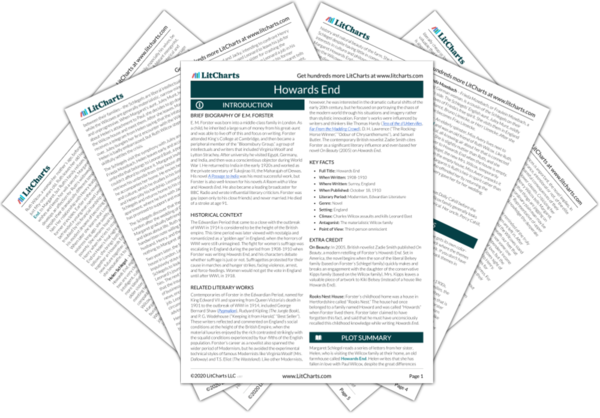Welcome to the LitCharts study guide on E. M. Forster's Howards End. Created by the original team behind SparkNotes, LitCharts are the world's best literature guides.
Howards End: Introduction
Howards End: Plot Summary
Howards End: Detailed Summary & Analysis
Howards End: Themes
Howards End: Quotes
Howards End: Characters
Howards End: Symbols
Howards End: Literary Devices
Howards End: Theme Wheel
Brief Biography of E. M. Forster

Historical Context of Howards End
Other Books Related to Howards End
Key Facts about Howards End
- Full Title: Howards End
- When Written: 1908-1910
- Where Written: Surrey, England
- When Published: October 18, 1910
- Literary Period: Modernism, Edwardian Literature
- Genre: Novel
- Setting: England
- Climax: Charles Wilcox assaults and kills Leonard Bast
- Antagonist: The materialistic Wilcox family
- Point of View: Third-person omniscient
Extra Credit for Howards End
On Beauty: In 2005, British novelist Zadie Smith published On Beauty, a modern retelling of Forster’s Howards End. Set in America, the novel begins when the son of the liberal Belsey family (based on Forster’s Schlegel family) quickly makes and breaks an engagement with the daughter of the conservative Kipps family (based on the Wilcox family). Mrs. Kipps leaves a valuable piece of artwork to Kiki Belsey (instead of a house like Howards End).
Rooks Nest House: Forster’s childhood home was a house in Hertfordshire called “Rooks Nest.” The house had once belonged to a family named Howard and was called “Howards” when Forster lived there. Forster later claimed to have forgotten this fact, and said that he must have unconsciously recalled this childhood knowledge while writing Howards End.







